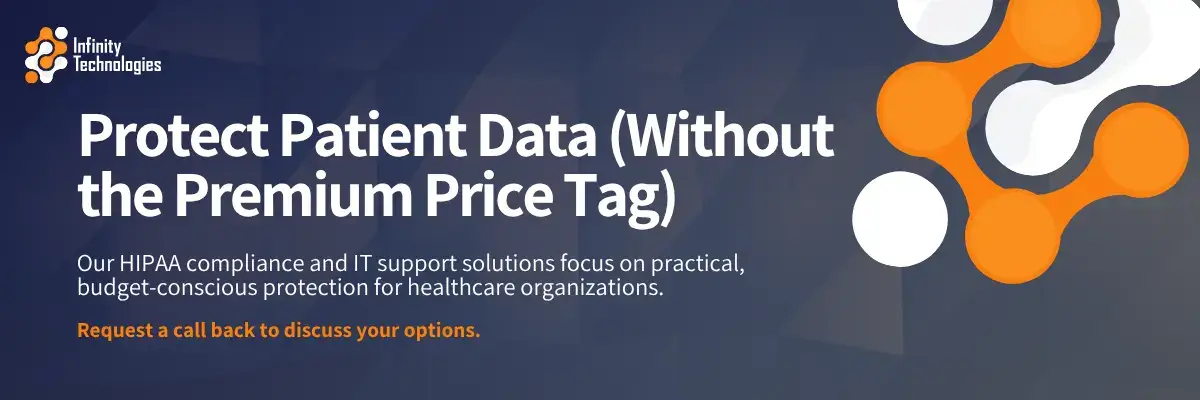Healthcare organizations face mounting pressure to safeguard patient information while managing tight budgets. With healthcare data breaches affecting over 278 million individuals in 2024 and the average cost of a healthcare data breach reaching $9.77 million, implementing solid HIPAA compliance and IT support strategies has never been more critical.
The good news? Protecting patient data doesn’t have to bankrupt your organization.
Small and midsized healthcare providers often believe data protection requires massive IT budgets. But strategic planning can deliver high-level security without high-level costs. This guide explores practical, budget-conscious strategies. They’ll help you understand the real benefits of professional IT support for HIPAA compliance.
Understanding the True Cost of HIPAA Non-Compliance
Before diving into solutions, it’s essential to understand what’s at stake. Over 55% of HIPAA fines in 2022 were levied against small practices, proving that size doesn’t protect organizations from regulatory scrutiny.
The financial impact extends far beyond immediate fines:
Direct Costs:
- Civil monetary penalties ranging from $100 to $50,000 per violation
- Breach notification expenses averaging $35,000 per physician annually
- Legal fees and compliance review costs
Indirect Costs:
- Reputational damage affecting patient trust and retention
- Business disruption during incident response
- Lost revenue from operational downtime
Clearly, IT support for data protection is a must across your entire digital ecosystem.
Cost-Effective Strategies for Patient Data Protection
Leverage Free and Low-Cost Security Tools
The foundation of cost-effective patient data protection doesn’t require expensive enterprise solutions. Start with these budget-friendly options:
Free Government Resources:
- HHS HIPAA Security Risk Assessment Tool for comprehensive vulnerability analysis
- OCR’s Cybersecurity Performance Goals (CPGs) providing actionable security frameworks
- NIST Cybersecurity Framework guidance tailored for healthcare
Essential Low-Cost Security Measures:
- Multi-factor authentication (MFA) implementation across all systems
- Regular automated backups with encrypted off-site storage
- Employee training programs using online platforms
- Basic endpoint protection software for workstations
Prioritize High-Impact, Low-Cost Improvements
Focus limited resources on security measures that deliver maximum protection per dollar invested:
Access Controls and User Management:
Implementing proper access controls costs significantly less than recovering from a breach caused by unauthorized access. Establish role-based permissions, ensuring employees only access data necessary for their job functions.
Regular Risk Assessments:
Annual risk assessments are mandatory under HIPAA, but they’re also one of the most cost-effective ways to identify vulnerabilities before they become expensive breaches. Many organizations can conduct basic audits internally with proper training.
Vendor Management:
Since business associates were responsible for 93 million exposed records in 2023, carefully vetting and monitoring your technology vendors is crucial. Ensure all business associate agreements (BAAs) are current and comprehensive.
Building Affordable IT Support for HIPAA Compliance
Outsourcing or In-House IT Support?
For many smaller practices, the question isn’t whether to invest in IT support for HIPAA compliance, but how to structure that support cost-effectively.
Managed Service Providers (MSPs):
- Offer 24/7 monitoring and support at predictable monthly costs
- Provide specialized HIPAA compliance expertise
- Include incident response and breach prevention services
- Scale services based on organizational size and budget
Hybrid Approaches:
- Maintain basic IT functions in-house
- Outsource specialized security monitoring and compliance oversight
- Use consultants for periodic assessments and training
Key Selection Criteria:
- HIPAA compliance experience in healthcare
- Transparent pricing with no hidden fees
- Comprehensive business associate agreements
- References from similar-sized healthcare organizations
Must-Have Healthcare Technology Investments That Pay for Themselves
While budget constraints are real, certain technology investments deliver immediate ROI through improved efficiency and risk reduction:
Electronic Health Records (EHR) with Built-in Security
Modern EHR systems include encryption, audit trails, and access controls as standard features. While the initial investment may seem substantial, these systems often pay for themselves through improved workflow efficiency and reduced paper-based vulnerabilities.
Automated Backup and Recovery Solutions
Ransomware attacks affect a significant number of healthcare facilities, making reliable backup systems essential. Cloud-based backup solutions offer enterprise-level protection at small business prices.
Employee Training Platforms
Since most healthcare data breach threats come from negligent employees, investing in regular training programs delivers measurable security improvements. Online platforms provide cost-effective, trackable training that satisfies HIPAA requirements.
Maximizing ROI from Your Security Investments
Documentation as a Cost-Saving Strategy
Proper documentation serves dual purposes: satisfying HIPAA requirements and reducing costs during audits or investigations. OCR’s enforcement actions frequently cite inadequate documentation, making this a critical area for investment.
Essential Documentation:
- Risk assessment findings and remediation plans
- Employee training records and attestations
- Incident response logs and follow-up actions
- Vendor agreements and compliance monitoring
Leveraging Technology for Efficiency
Automation Opportunities:
- Automated log monitoring and alerting
- Scheduled security updates and patches
- Regular backup verification and testing
- Compliance reporting and tracking
Integration Benefits:
- Reduced manual processes and human error
- Consistent application of security policies
- Improved visibility into security posture
- Streamlined audit preparation
Common Pitfalls in IT Support for HIPAA Compliance (and How to Avoid Them)
Over-Engineering vs. Under-Investing
Finding the right balance between comprehensive protection and budget constraints requires careful planning:
Avoid Over-Engineering:
- Focus on practical solutions that address real risks
- Implement scalable solutions that grow with your organization
- Prioritize high-impact measures over impressive but unnecessary technology
Avoid Under-Investing:
- Don’t rely solely on basic antivirus software
- Ensure regular updates and maintenance of security systems
- Invest in proper training beyond one-time orientation sessions
Vendor Selection Mistakes
Red Flags to Avoid:
- Providers unwilling to sign comprehensive BAAs
- Unclear pricing structures with hidden fees
- Lack of healthcare industry experience
- Inadequate references or case studies
Best Practices:
- Request detailed security assessments from potential vendors
- Verify certifications and compliance credentials
- Negotiate service level agreements with specific response times
- Establish clear performance metrics and regular reviews
Measuring Patient Data Protection Success
Key Performance Indicators (KPIs)
Track these metrics to ensure your cost-effective patient data protection strategy delivers results:
Security Metrics:
- Number of security incidents and response times
- Employee training completion rates and assessment scores
- Vendor compliance assessment results
- Risk assessment findings and remediation progress
Financial Metrics:
- Security investment as a percentage of the total IT budget
- Cost per protected record
- Return on investment from security improvements
- Avoided costs from prevented incidents
Regular Review and Optimization
Quarterly Reviews:
- Assess security posture against emerging threats
- Review vendor performance and contract terms
- Update risk assessments based on organizational changes
- Evaluate employee training effectiveness
Annual Planning:
- Budget allocation for upcoming security investments
- Strategic planning for technology upgrades
- Compliance program maturity assessment
- Long-term security roadmap development
FAQs
Q1: What’s the minimum budget needed for basic HIPAA compliance?
Small healthcare practices can establish basic HIPAA compliance and IT support for as little as $2,000-5,000 annually by focusing on essential elements like risk assessments, employee training, basic access controls, and secure backup solutions.
However, costs vary significantly based on practice size, existing technology infrastructure, and chosen security measures.
Q2: Can we handle HIPAA compliance in-house, or do we need external IT support?
While basic compliance activities can be managed internally with proper training, most organizations benefit from external expertise for specialized areas like risk assessments, security monitoring, and incident response.
A hybrid approach often provides the best cost-effectiveness, maintaining routine IT functions in-house while outsourcing specialized compliance and security services.
Q3: How often should healthcare providers conduct security risk assessments, and what do they typically cost?
HIPAA requires annual risk assessments at minimum, though many experts recommend semi-annual or quarterly reviews when determining how to protect patient data effectively.
Basic internal assessments using free HHS tools cost primarily staff time, while comprehensive third-party assessments range from $5,000 to 15,000 depending on organization size and complexity.
Q4: What are the most cost-effective ways to train employees on HIPAA compliance?
Online training platforms offer the most cost-effective solution, typically costing $25-100 per employee annually. These platforms provide trackable completion, regular updates for regulatory changes, and standardized content that satisfies HIPAA training requirements.
Supplement online training with regular security awareness communications and simulated phishing exercises.
Q5: How can we ensure our vendors maintain HIPAA compliance without breaking our budget?
Focus on vendor due diligence during selection rather than expensive ongoing monitoring for IT support for data protection. Require comprehensive business associate agreements, request security certifications and audit reports, check references with similar healthcare organizations, and establish clear performance expectations.
Many compliance failures can be prevented through proper vendor selection and contract management rather than costly monitoring systems.
Get Expert IT Support for HIPAA Compliance and That Fits Your Budget
Don’t let compliance costs overwhelm your practice. Our healthcare IT specialists deliver enterprise-level patient data protection at small business prices.
Request a call back to find out more.



